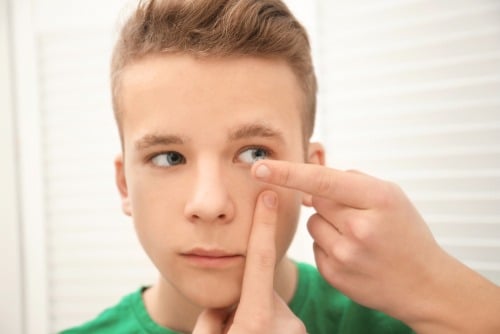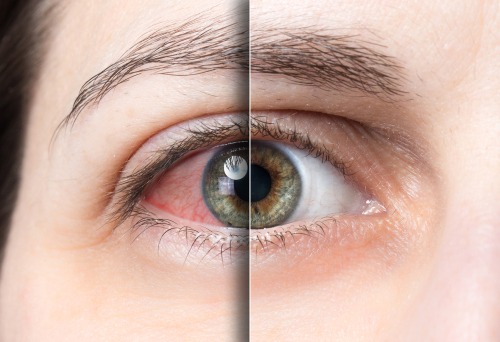Children & Contact Lenses: When Is the Right Time?
Is your child ready to switch from glasses to contacts? We discuss contact lenses for kids, including at what age can a child wear contact lenses. Read more.
Contact Lenses for Kids: When Is the Right Time?
For some children, switching from eyeglasses to contacts is an exciting transition.

Whether your child has expressed interest on their own about making the shift, or you feel like they’re ready to take the leap, you probably have several questions about contact lenses for kids – including at what age can a child wear contact lenses?
Let’s run through important insights about contact lenses for kids and discuss how we can personally assess your child’s vision to determine if he or she is ready to make the change.
Are Contact Lenses Safe for Kids?
When it comes to children and contact lenses, the question most frequently asked by parents and caretakers is, “Are contact lenses safe for kids?”
The short answer is: It depends.
Contact lenses are safe for kids, but…
Much more than just knowing they’re safe, parents and caretakers MUST acknowledge that the safety of them relies on the child’s maturity and ability to handle the responsibility of wearing and caring for contact lenses. These factors are more important than the kid contact lenses age suggestion.
At What Age Can a Child Wear Contact Lenses?
While every eye care professional will have his or her own stance on when it is appropriate to introduce a child to soft contact lenses, generally speaking, kid contact lense age range is between 8-14 years old.
The age gap may seem large to some, but as every parent can attest to, children develop and mature at different rates. Some children demonstrate signs of responsibility and maturity at a young age and may be ready to wear contact lenses when they’re eight; others may not be ready until age 12, 14 or older.
Is Your Child Ready?
Two simple things parents need to make sure of:
- Does your child understand the benefits of not wearing eyeglasses?
- Can your child follow their eye doctor’s instructions for eye care exactly, day after day?
As pediatric optometrists, we see an abundance of children every day. What we commonly recognize is if a child needs to be constantly reminded of good grooming habits and/or organizational skills, they may not be ready for contact lenses and should remain wearing glasses at this time.
Because contact lenses can cause vision issues, eye irritation and eye infection, or – at worst – vision loss if not handled correctly (like stored in a proper, safe place or removed at necessary times) it’s best to wait until your child is completely ready to own this new lifestyle.
Benefits & Drawbacks of Contact Lenses for Kids
Without question, children can benefit in multiple ways by wearing contact lenses. The benefits of contacts include:
Controlling Nearsightedness
For some myopic children, contact lenses can slow the progression of nearsightedness. Some studies have even shown that certain, specially designed contact lenses – like gas permeable and multifocal soft contacts – can provide a substantial amount of myopia control in many children who live with nearsightedness.
Additionally, a recent study showed that 90 percent of children who live with nearsightedness had no trouble applying or removing the contacts without assistance from their parents.1
Building Self-Esteem
To most parents, this may come as no surprise: Many children feel self-conscious wearing eyeglasses and some children just don’t like the way they look in glasses.
Studies have shown that in addition to vision correction, wearing contact lenses may improve how some children feel about their appearance and the number of activities they participate in.1
Sports
For children who play a sport, contact lenses obviously offer a number of advantages over glasses, such as:
- Consistent, stable, crisp vision
- An unobstructed view of the playing field, making for better peripheral vision
- No worry of frames breaking and causing an eye injury
In contrast, there are some drawbacks of contact lenses for kids and rules for wearing them.
As discussed above, contact lenses do come with risks if not handled with cleanliness and responsibility. Because eye irritations, infections or vision issues and loss can result from improper contact lens wear, it’s vital that parent and child both know these drawbacks and become well-versed on the rules of use with all types of lenses, including daily disposable contact lenses:
- Know how to properly disinfect and handle them
- Know when to replace them
- Know to not share or swap contact lenses with another person
- Know to never use spit, tap water, distilled water, or homemade non-sterile saline solution to clean them
- Know to apply makeup after contact lenses are in place
- Know it is best to use hypoallergenic skin products, or products specifically marked “for contact lens wearers” or “for sensitive eyes”
- Know to always remove the contact lenses at the first sign of irritation
Additional, Good-to-Know Info: 5 Resources to Understand Child Vision Problems
As we close our discussion on contact lenses for kids, we must conclude on one of the most important vision-related topics: vision problems in children.
Did you know vision is the primary sense by which we learn?
Knowing if your child’s vision is fully supporting their living and learning needs is paramount to their development, success, comfort and happiness. Learn about vision problems in children and discover the signs of vision problems in babies, toddlers and children through our related articles:
- Signs of Vision Problems in Children
- Could Your Child’s Behavioral Problems Be Linked to Poor Vision?
- 80% of the Brain is Visual
- How IEP and 504 Plans Relate to Vision
- Could your Child’s Disinterest in Reading be Linked to Problems with Vision?
Let iCare Vision Help You Make an Informed Decision on Contact Lenses for Your Child & Ensure Their Vision is Healthy
Do you think your child is ready for contact lenses? It’s an exciting step and we’re excited to discuss the process with you and your child.
Through a quick and painless healthy eye exam, the eye care professionals at iCare Vision will get an accurate picture of your child’s overall vision and identify or revisit any issues he or she is contending with.
From there, we will know they type of lens support your child needs and can conclude whether or not he or she is a good candidate for contact lenses at this time, based on several contributing factors.
Schedule an appointment to come in and see us soon:
For Kids & Teens: Are You Sure You’re Ready for the Responsibility of Contacts?
Do you feel like you’ve outgrown your bulky glasses? Are you very interested in wearing contact lenses?
Contact lenses are a big responsibility, as they require a lot of care and upkeep to make sure your eyes stay healthy.
- Think about how well you keep up with other parts of personal hygiene, such as showering, brushing your teeth, flossing, etc. If you’re good with your personal hygiene, adding contact lenses into your routine shouldn’t be a problem. (Remember, they must be cleaned regularly, usually every day.)
- Do you pay attention to your overall health? For contact lenses, it’s important you’re good at attending to and communicating health issues you’re experiencing.When wearing contacts, you could start to experience itching, redness, or irritation in your eyes. Once you notice these signs, you must take the lenses out and have your eyes checked by an eye doctor. If you ignore issues, you could face serious problems with your eyes.
- Do you know the potential risks that come with wearing contact lenses? When used properly, contact lenses are very safe. The risks come from wearing them longer than you’re supposed to, not cleaning them right, or not taking them out at night. These risks can lead to eye ulcers and infections.
If you feel you’re ready for contact lenses, we’re here to help you make the transition.
Resources:
1 All About Vision. Are contact lenses a good choice for kids? Accessed August 4, 2019. https://www.allaboutvision.com/parents/contacts.htm.

